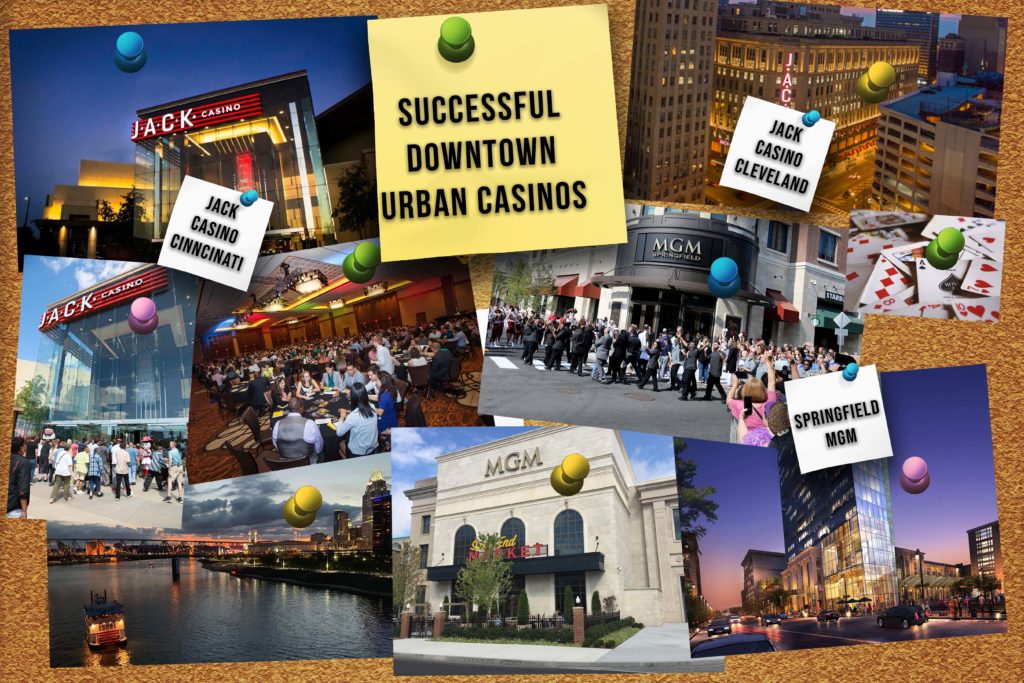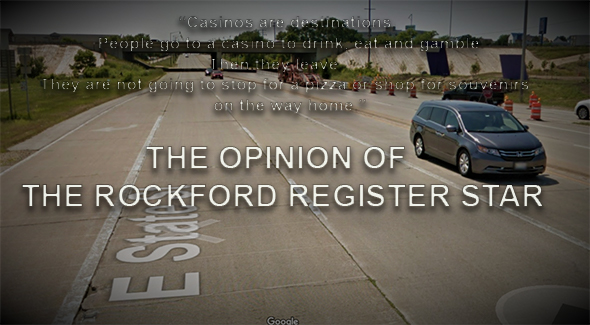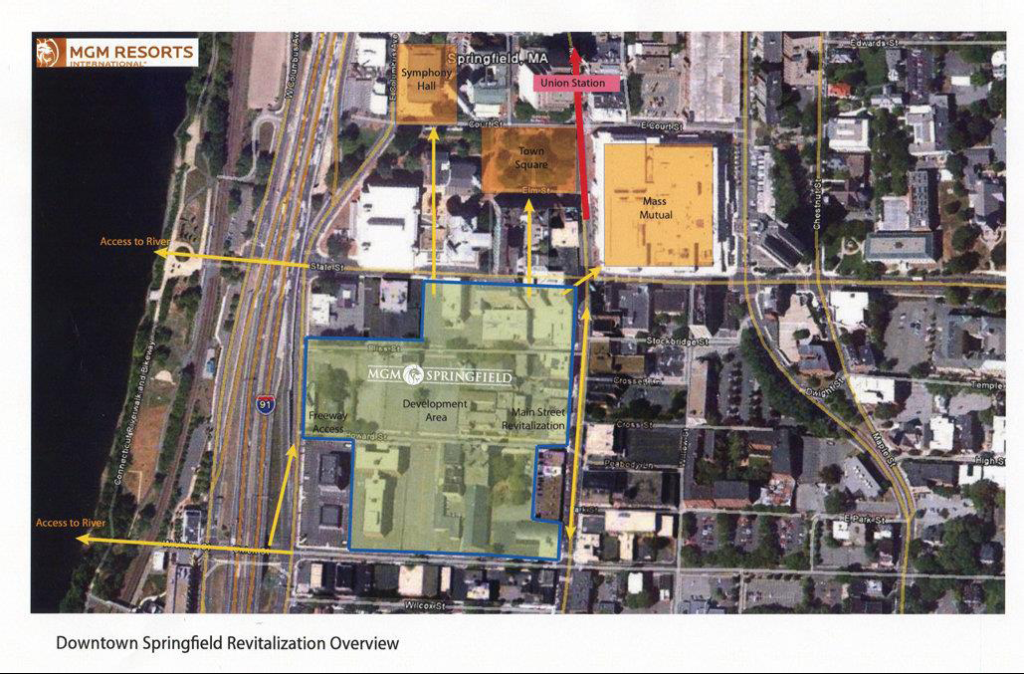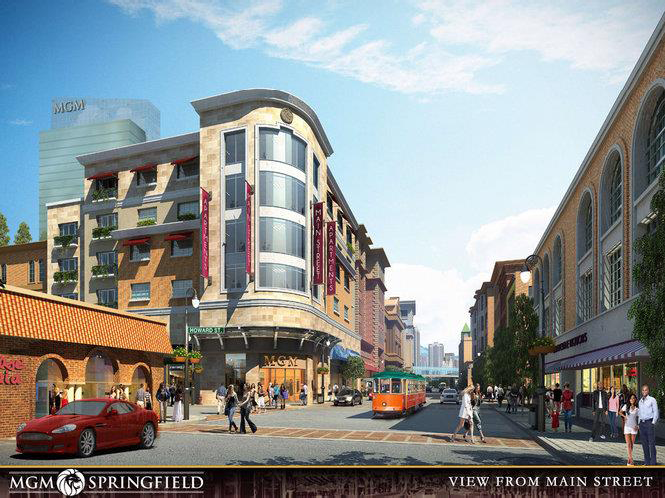Excerpt from Article- Rockford is Right to Roll with Hard Rock:
“Casinos are destinations. People go to a casino to drink, eat and gamble.
Then they leave.
They are not going to stop for a pizza or shop for souvenirs on the way home.
It doesn’t happen.”
Island Casinos
What the Rockford Register Star Opinion page has described, is the Island Casino Business Model. In fact, the vast majority of casino development in North American cities can best be described as island casino development, as stated by the Opinion of the Newspaper. This term refers to casinos that are built as self-contained developments. Rather than just an opinion, there is Empirical Data based on the Casinos worldwide, showing that Island Casinos are physically separated from the surrounding community. (Source: Klebanow, Andrew M., Casinos and the City: A White Paper on the History of Casino Development in Cities, Past and Current Trends, and Recommendations for Future Development, Global Market Advisors LLC)
Some, including our Senator Dave Syverson, believe the Clock Tower Casino proposal is best for Rockford because new regional casinos were built at the fringe of communities and replicating that is easy. However, while the site is easy to build and will have I-90 visibility, it fails to leverage the value of a casino property as part of a downtown revitalization strategy. Let’s not repeat past mistakes by sprawling east or not recognizing the value of the potential before us.
New Urbanism is a movement that works to restore life into city downtown locations across America that lost their bustle to sub-urbanization. Suburbanization is a population shift from central urban areas into suburbs. Rockford’s downtown area is a perfect example of the New Urbanism Movement. Our downtown’s story reads something like a hero’s journey- a place that was once the central business district that lost its business boom but is now rising again.
Urban Casino Business Model
What does it mean to have an Urban Casino at the Waterpower Entertainment District in Downtown Rockford? Placing the Urban Casino Business Model in the downtown area would act as a catalyst to an area that is already on the rise. By combining elements of New Urbanism, city planners, casino operators, and developers can integrate a casino development into the fabric of the urban riverfront. This happens in such a way that the downtown casino becomes an integral element in the commercial activity of the community. In just one example, the proposal provides a partnership with the entire downtown and businesses for the co-promotion of the downtown and by providing complimentary meals and drinks in local establishments paid for by the casino. This long-lasting partnership is common with urban casino operators as is the case of the CMS Group. This operator is one of the most experienced gaming and hospitality professionals in the USA focused on the development, management, and marketing of gaming businesses, hotels and restaurants.

- Urban Casino Operators embrace their downtown neighbors by partnering with them to create additional amenities for their guests.
- Urban Casino Operators partner with local venues already in place and support and host concerts and events on an ongoing basis.
- Urban casinos traditionally are committed to serving the communities in which they do business.
- Urban Casinos Operators, as part of their mission, believe strongly in the philosophy of giving back. Their team members on the entertainment campus regularly participate in events such as food and toy drives, school supply drives, walkathons, and volunteer days.
- Their teams from the restaurants, hotels, retail shops, and casinos extend beyond cash donations as they also volunteer their time and energy.
- Urban Casinos are designed from the ground to engage pedestrians and support downtown businesses, culture, nightlife, and sports attractions wherever they are implanted within a Community.
- While Urban Casino guests are indeed locals from all quadrants of a community, each property does see a large and significant number of guests from outside the community, driving to this destination or being charted to the entertainment destination by multiple motor coach lines serving from multiple adjacent states.
- As part of their marketplace vision, Urban Casino Operators know that while Baby Boomers are part of their entertainment customer base, Millennials, and their younger cohorts will reshape the Casino industry into the future, with their tech-savvy, mobile-first image, with ramifications for all companies and communities alike.
- The outdated Island Casino model, much like their first cousin the bricks and sticks of the banking location, is not as relevant to these groups. Millennials, who this year became the most populous generation in the U.S. at 73 million, overtaking the 72-million-strong post-war Baby Boomers, are changing the face of commerce. Unlike their parents, Millennials want more family-friendly and multiple fun entertainment venues that are hosted in an Urban Casino gateway. Operators have been waiting a while for this next pocket of growth. Gen X, which hit its 25- to 40-year-old entertainment stride this year, have significant disposable income.
- Urban Casino Operators design their entertainment campus projects which allow the casino to connect to the street grid and allow for the free flow of pedestrians and tourists into and out of the property, which is so, so very different from an Island Casino Destination structure.
- Unlike the Urban Casino, Island Casinos are true “islands” onto themselves with no economic benefit or gain to the neighboring business, as the old expression goes, “They Dine & Dash!”
The Concentric Circles of Economic Impact
When a round pebble is dropped into a calm pond, it causes ripples in the form of concentric circles. Similar to the pebble, the urban casino is the stone and the pond is the downtown entertainment district. The concentric circles are the economic impacts that can be forecasted with similar effects of the pebble hitting the still water.
These concentric circles rippling out from the locus point of where the pebble hit the water will bring new entrepreneurs, new franchises, new corporate entities, to say the least, pointing the way to a new future for our city, county, the whole of the Rock River Valley. This hypothesis is not theoretical, it is a proven economic engine that is proved repeatedly through the distribution, and consumption of goods and services of a regional economy.
It also has a direct correlation to employment and increased incomes in our community. From a straightforward Marco/Microeconomic point of view, all the supply and demand across our region will be impacted for the better. There is no single perfect method to estimate the economic impacts that the Urban Casino at the Waterpower Entertainment District will have on our community or our region, however, like the pebble hitting the water and creating the concentric circles, it will happen.
Citations and Resources
Casinos and the City: A White Paper on the History of Casino Development in Cities,
Past and Current Trends, and Recommendations for Future Development
Andrew M. Klebanow
TWELVE CITATIONS – SIGHTED, EXTRACTED & HIGHLIGHTED
EXCERPTS:
- This white paper examines the history of gaming development in cities and their evolution. Using examples of early efforts, notable successes, and failures, as well as current trends in urban casino development.
- This white paper offers suggestions on how casinos can be made into tools for urban regeneration, providing not only jobs and taxes, but stimulate commercial activity around the casino and enhance the quality of the communities in which they are located.
- This white paper hopes to show, if planned well, a casino can offer benefits to its host community that goes far beyond taxes and jobs.
TERMS USED:
- “URBAN CASINO”
- “The terms, “Urban Casino” or “Urban Gaming,” are used in a variety of contexts. Historically, they have been used to broadly describe casinos which have been developed within the boundaries of American cities. They include everything from the casinos along the boardwalk in Atlantic City to casinos housed on riverboats and barges moored near central business districts and in the industrial zones of many Midwestern cities.”
- “ISLAND CASINO”
- “The vast majority of casino development in North American cities can best be described as island casino development. This term refers to casinos that are built as self-contained developments. They are physically separated from the surrounding community.”
- CITATION 1.
- “Communities desperately needed. Nevertheless, cities have missed another opportunity: to take advantage of those thousands of daily visitors and allow them to spend their money in the shops and restaurants of their central business districts.”
- CITATION 2.
- “During the latter half of the twentieth century, North America underwent a period of suburbanization. Shopping malls, sports venues, and office developments were built on cities’ outer edges where large plots of land were readily available as was access to new highways and new residential populations. This, in turn, brought about a decline in the central business districts of many North American cities.”
- CITATION 3.
- “The notion of using casinos, with their high daily visitation rates and customers, to drive foot traffic back to the urban core eluded many city planners and those in government tasked with determining where to locate proposed casinos. Rather, casinos were allotted plots of land far away from cities’ traditional central business districts or entertainment zones. To many community leaders, casinos seemed incompatible with other entertainment activities such as sporting events, dining, and shopping.”
- “This strategy, repeated cities throughout the Midwest United States, ignored the fact that casinos were capable of delivering thousands of visitors on a daily basis and with them, the ability to stimulate other commercial enterprises.”
- CITATION 4.
- “Beginning in the 1990s, state governments legalized gaming on riverboats and barges. Iowa, Indiana, Illinois, Missouri, and Louisiana further required that gaming activities be conducted only while riverboats cruised. Casinos that were restricted to riverboat gaming were built as stand-along operations and their primary contributions to the local community came in the form of tax revenue and jobs.”
- “Over the past two decades, the vast majority of riverboat/barge casinos added hotels and other non-gaming amenities in order to better serve their casino guests. However, their remote locations precluded any opportunity to integrate these amenities into other city entertainment activities. These casinos essentially became self-contained islands within the confines of a larger urban environment.”
-
- “Over twenty years have passed since the first riverboat casinos were introduced into cities seeking the economic benefits of casino development, primarily tax revenue and job creation. Casinos have delivered on that promise, having collectively created tens of thousands of jobs and contributed billions of dollars in tax revenue.”
- “Their secondary purpose, to act as a catalyst for urban regeneration. What can be learned is that urban gaming development is evolutionary, with each project learning from predecessor developments.”
- CITATION 5.
- “Onerous restrictions by local government designed to appease powerful constituents can easily force a development to fail. A casino is an entertainment venue that targets multiple market segments and must be permitted to offer amenities that appeal to diverse groups of people. These include multiple dining options, attractive gaming environments, entertainment venues, lounges, and lodging facilities. When the government restricts the kinds of amenities that a casino can offer in order to solely benefit one group of constituents, it constricts the contributions the casino development can make to the community and, at its worst, dooms the project to failure.”
- CITATION 6.
- “The Macau Peninsula. There is no better example of casinos working harmoniously with their surrounding neighbors than the casinos that comprise the central casino district on the Macau Peninsula. The properties offer multiple entry points, allowing patrons to walk into the street grid, walk from casino to casino and nearby stores. Hundreds of shops targeting tourists have sprung up on the streets and alleys surrounding casinos, creating a vibrant commercial zone.”
- CITATION 7.

- “MGM Springfield received voter approval and subsequently a gaming license for a new kind of urban casino, integrated into the fabric of an existing neighborhood. The site for the casino-resort, bounded by an interstate highway to the west and a commercial zone to the east. The site is also in close proximity to an arena and symphony hall.”
- MGM proposed a design that allowed the casino to connect to the street grid and allowed for the free flow of pedestrians and tourists into and out of the property. It offered restaurants that faced the main boulevard and brought what is a massive project down to street level scale. It was this design and consideration of the needs of the surrounding neighborhood that allowed MGM Resorts to receive approval from the local community and with it, a license to operate one of three casinos in the state.”
- CITATION 8.
- THE CASINO AS A TOOL FOR URBAN REDEVELOPMENT. “Properly planned and executed, a casino can have a greater, positive impact than other forms of urban regeneration at far less cost to the city. In many ways, a casino is like any other large commercial enterprise that attracts thousands of people a day. An arena, ballpark or convention center all attract and accommodate large amounts of people. A portion of those visitors in turn spill into the surrounding commercial zones and spend money in restaurants and stores. What sets a casino apart is that it attracts people every day of the year, rather than on game days or when a convention is scheduled.”
- CITATION 9.
- CASINOS MUST BE DESIGNED TO INTEGRATE INTO THE STREET GRID. “Working with the developer, the government should identify a zone within the city that would be designated as an entertainment/commercial development zone. This zone would have within it certain qualities that assure compatibility with surrounding businesses such as restaurants, nightclubs, hotels, and theaters. The zone would also be near both mass transit, and the region’s highways and the site should be of sufficient size to support a gaming enterprise. An urban casino stands the greatest chance of success when it is located on a site that is mutually compatible with surrounding businesses.”
- CITATION 10.

- THE MODERN URBAN CASINO. “An urban casino allows for the free flow of pedestrians to and from the casino and the surrounding neighborhood and the resulting economic activity that such pedestrian flow generates. Properly designed, an urban casino creates a positive impact on the surrounding neighborhood by increasing retail and commercial activity, stimulates additional retail and commercial development and ultimately benefits the casino operator by increased foot traffic into the casino. A properly designed urban casino is both a tool for urban regeneration and an enhancement to casino performance.”
- CITATION 11.
- URBAN CASINO DEVELOPMENT AND NEW URBANISM. “The modern urban casino can be compatible with many of the principles of New Urbanism and the newest generation of urban casinos supports this theory. Its goal was to reform many aspects of real estate development and urban planning, from urban retrofits to suburban infill. New urbanist neighborhoods are designed to contain a diverse range of housing and jobs, and to be walkable.
- New urbanism was a reaction to urban sprawl, a system of development with a rigorous separation of uses, known as suburban development. New Urbanism, on the other hand, was based on planning and architectural principles working together to create human-scale, walkable communities. It is rooted in the work of architects, planners, and theorists who believed that conventional planning thought that led to the rise of American suburbs was failing.”
- CITATION 12.
- FACTORS FOR THE MODERN URBAN CASINO
- “By combining elements of New Urbanism, urban planners and casino developers can integrate a casino development into the fabric of the urban neighborhood in such a way that the casino becomes an integral element in the commercial activity of the community. Urban casino development should include the following elements:
- WALKABILITY TO COMPELLING, COMMERCIALLY VIABLE NEIGHBORHOODS
- “It must be within a short walking distance to a neighborhood that is not only commercially active but offers appealing retail and cultural activities. Dining, nightlife, cultural activities, and unique shopping experiences are compelling reasons for casino patrons to venture out of the gaming property and into the surrounding neighborhood.”
- ACCESS TO PUBLIC TRANSPORTATION
- “A key element of any urban gaming development is for patrons of the casino development to have close access to a city or region’s mass transit network. Buses, light rail systems, and commuter rail stations need to be in close proximity to the casino development in order to limit the casino’s dependence on customers arriving by automobile and limit automobile traffic into the urban core.”
- ACCESS TO THE LOCAL/REGIONAL HIGHWAY NETWORK
- “All casinos require access to local roadways that interconnect with regional highway networks. A successful urban casino must, therefore, be accessible to a regional highway network”.
- A SITE LARGE ENOUGH TO SUPPORT A CASINO AND SUPPORTING AMENITIES
- “An integrated casino resort requires a footprint of sufficient acreage in order to accommodate a full-service casino, hotel, conference & meeting space, retail and support services such as parking and warehousing.”
- MULTIPLE ACCESS AND EGRESS POINTS
- “A well-designed urban casino offers pedestrians the ability to enter and leave the casino directly into the street grid. Island casinos have limited ingress/egress points. A successful urban casino must be porous so that patrons can enter and leave through multiple points.”
- THE ABSENCE OF PHYSICAL BARRIERS
- “Urban planners have long recognized that physical barriers such as highways, train tracks, parking garages, large expanses of surface parking and other physical buffers impede pedestrian traffic and separate neighborhoods. These buffers act as psychological obstacles to the movement of people into and out of the casino.”
- SCALE THE CASINO PROJECT TO STREET LEVEL
- “Casinos, like hotels and convention centers, are large edifices. However, scaling the entrances to the casino to street level makes ingress appealing. Street-level activities (pushcarts, kiosks, fountains) that bring the project to a street-level scale.”
- PROPER LOCATION OF BACK OF HOUSE FACILITIES
- “Casinos require copious amounts of goods delivered each day in order to properly service their guests. Casinos also generate large amounts of trash (Loading docks, dumpsters and warehousing facilities are natural barriers to the free flow of pedestrians.”
- ENCOURAGE DEVELOPMENT OF OR ACCESS TO AN ENTERTAINMENT/DINING DISTRICT
- “The single greatest factor in designing a successful Urban Casino is identifying a casino site that is in close proximity to other retail, dining and entertainment options. If a casino is located too far from such a district, it will never be able to generate the foot traffic between the casino and the commercial zone. Zoning, tax abatements, sidewalk construction and other civic improvements can be used to encourage local entrepreneurs to open businesses near the casino that are compatible with a building that provides multiple kinds of entertainment.”
- STREET CALMING AND PEDESTRIAN-FRIENDLY ENVIRONMENTS
- “Vehicular traffic between the casino and the commercial/entertainment district must be calm enough for pedestrians. sidewalks, crosswalks, streetlights and street lighting in order to make transit between the commercial/entertainment zone and casino safe and attractive.”
- THE CASINO’S RELATIONSHIP WITH THE SURROUNDING COMMUNITY MATTERS
- “Allowing casino patrons to redeem their frequent player points at neighborhood businesses enhances the value of the rewards program while benefiting neighborhood shop owners. Relying on local restaurants and clubs to provide additional dining and entertainment options reduces the capital costs and operating costs of the casino and fosters the development of neighborhood dining and entertainment venues. How a casino is perceived by the surrounding neighborhood is a critical success factor and one that must be underscored.”




